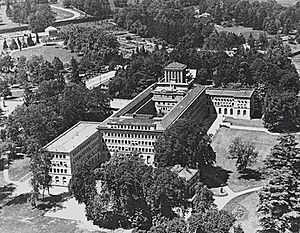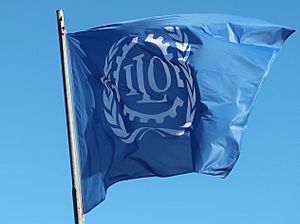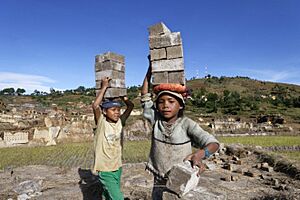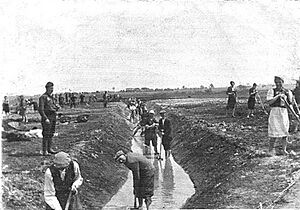International Labour Organization facts for kids
Quick facts for kids  International Labour Organization |
|
|---|---|
| Org type | United Nations specialized agency |
| Status | Active |
| Headquarters | Geneva, Switzerland |
The International Labour Organization (ILO) is a special agency of the United Nations (UN). Its main job is to help make sure that people around the world have fair and safe working conditions. It does this by creating international rules for work, called "labour standards."
The ILO was started in October 1919, right after World War I, as part of the League of Nations. This makes it one of the oldest UN agencies. Today, 187 countries are members of the ILO. Its main office is in Geneva, Switzerland, but it has about 40 smaller offices worldwide.
The rules the ILO creates are meant to help everyone find good jobs that are safe, fair, and respectful. These rules cover important things like the right to join a union, stopping forced labour, ending child labour, and preventing unfair treatment at work. The ILO is a big part of creating international laws about work.
What makes the ILO special is its unique structure. When it makes decisions about rules or programs, it always includes three groups: governments, employers, and workers. This way, everyone's voice is heard. In 1969, the ILO won the Nobel Peace Prize for its work in promoting peace and fairness for workers around the world.
Contents
How the ILO Works
Unlike most other UN agencies, the International Labour Organization (ILO) has a special way of making decisions. It brings together representatives from three groups: governments, employers, and workers from all its 187 member countries. This is called a "tripartite" structure. It helps make sure that the rules and programs the ILO creates are fair to everyone involved in the world of work.
The Governing Body
The Governing Body is like the executive committee of the ILO. It meets three times a year to make important decisions. These decisions include setting the ILO's policies, planning what will be discussed at the big annual conference, and approving the budget. This body also chooses the Director-General, who leads the ILO.
The Governing Body has 56 main members. These include 28 government representatives, 14 employer representatives, and 14 worker representatives. Ten of the government seats are always held by major industrial countries like Brazil, China, France, Germany, India, Italy, Japan, Russia, the United Kingdom, and the United States. Other government members are chosen every three years.
The Director-General
The Director-General is the main leader of the ILO. On October 1, 2022, Gilbert Houngbo from Togo became the new Director-General. He is the first African person to hold this important position.
Here is a list of the leaders of the ILO since it began in 1919:
| Name | Country | Term |
|---|---|---|
| Albert Thomas | 1919–1932 | |
| Harold Butler | 1932–1938 | |
| John G. Winant | 1939–1941 | |
| Edward J. Phelan | 1941–1948 | |
| David A. Morse | 1948–1970 | |
| Clarence Wilfred Jenks | 1970–1973 | |
| Francis Blanchard | 1974–1989 | |
| Michel Hansenne | 1989–1999 | |
| Juan Somavía | 1999–2012 | |
| Guy Ryder | 2012–2022 | |
| Gilbert Houngbo | 2022–present |
The International Labour Conference
Once a year, the ILO holds the International Labour Conference (ILC) in Geneva. This big meeting is sometimes called the "international parliament of labour." At the conference, important decisions are made about the ILO's overall goals, its work plan, and its budget. The conference also elects members to the Governing Body.
Each member country sends a group of people to the conference. This group includes two government representatives, one employer representative, and one worker representative. Everyone has an equal vote, no matter how big or small their country is. The employer and worker representatives are usually chosen by the main employer and worker groups in their country.
Even though there are many different viewpoints, decisions are often made with a lot of agreement. Important leaders like heads of state also attend the conference. Other international groups can come as observers.
ILO Membership
The ILO has 187 member countries. Almost all (186 out of 193) UN member states are part of the ILO, plus the Cook Islands. A few UN member states are not members of the ILO, such as Andorra, Bhutan, and North Korea.
Any country that is a member of the UN can join the ILO. They just need to tell the Director-General that they agree to follow the ILO's rules. Countries that are not part of the UN can also join if two-thirds of the delegates at an ILO General Conference vote for them. The Cook Islands, which is not a UN member, joined in 2015.
ILO's Rules for Work
The ILO creates international rules and guidelines to improve working conditions. These rules are very important for protecting workers' rights around the world.
Conventions: International Work Laws
The ILO has adopted 189 "conventions." These are like international treaties or laws. If enough countries agree to and sign a convention, it becomes legally binding for those countries. This means they must follow its rules. Even if a convention isn't signed by a country, it's still seen as an important international standard for work.
Every year, a special committee at the International Labour Conference checks if countries are following the conventions they have signed. Governments have to send reports explaining how they are meeting their obligations.
In 1998, the ILO created a special declaration called the Declaration on Fundamental Principles and Rights at Work. This declaration highlights four basic rights that all member countries should work to protect:
- The right for workers to join unions and negotiate together for better conditions.
- The end of all forms of forced or compulsory labour.
- The complete end of child labour.
- The end of unfair treatment (discrimination) in jobs and occupations.
Most ILO member countries have signed the conventions that support these basic principles.
Recommendations: Guidelines for Better Work
Recommendations are like guidelines. They are not legally binding like conventions, so countries don't have to sign them. Recommendations often give more detailed advice on how to put conventions into practice. Sometimes, they cover issues that aren't part of a specific convention.
How the ILO Started
The ILO was created after World War I in 1919. But the idea of protecting workers internationally had been growing for a long time before that. Many people, including workers' groups and social thinkers, believed that there should be international rules to make work fairer.
During World War I, workers' groups pushed for better protections for working people. After the war, many countries wanted to rebuild and improve conditions for workers. They also wanted to prevent future conflicts by addressing social problems.
At the Paris Peace Conference in 1919, where the peace treaty was being written, leaders decided to include rules about protecting workers' rights. They also agreed to create an international organization to guide future labour relations. This led to the creation of the ILO. The first International Labour Conference was held in Washington, D.C., in October 1919. It adopted the first six international labour conventions, covering things like working hours, unemployment, and maternity protection.
The United States did not join the ILO at first because it didn't join the League of Nations. However, in 1934, the U.S. joined the ILO without becoming a member of the League of Nations.
During World War II
During World War II, when Switzerland was surrounded by German troops, the ILO temporarily moved its offices. In August 1940, the Canadian government invited the ILO to stay at McGill University in Montreal. About 40 staff members worked from there until 1948.
After the League of Nations ended in 1946, the ILO became the first specialized agency of the new United Nations system.
Cold War Era Challenges
In the 1970s, the ILO faced some challenges, especially from the United States. In 1975, the ILO voted to give the Palestine Liberation Organization (PLO) observer status. The U.S. and Israel walked out of the meeting. The U.S. then decided to stop funding the ILO and fully withdrew in 1977, saying the organization had become too political. The U.S. returned to the ILO in 1980.
The ILO also played a role in supporting the Polish trade union Solidarność in the 1980s. When the Polish government declared martial law and stopped Solidarność's activities, the ILO investigated and found that Poland had violated workers' rights. The ILO, along with other countries, put pressure on the Polish government, which eventually recognized Solidarność again in 1989.
ILO Offices Around the World
ILO Headquarters

The main office of the ILO is in Geneva, Switzerland. It first moved to Geneva in 1920. The current headquarters building was built between 1969 and 1974. It was the largest administrative building in Switzerland at the time.
Regional and Local Offices
The ILO has regional offices that cover large parts of the world, like Africa, Asia and the Pacific, Europe, Latin America, and the Arab States. These offices help carry out the ILO's work in different areas.
It also has smaller "sub-regional" offices, called "Decent Work Technical Support Teams." These teams provide expert help to groups of countries. For example, there are teams for North Africa, West Africa, and Central America.
Finally, the ILO has many country and liaison offices in cities all over the world, from Abidjan to Washington, D.C. These local offices help the ILO work directly with governments, employers, and workers in each country.
Important ILO Programs
Labour Statistics
The ILO collects and shares a lot of information about work and jobs. This includes statistics on employment, unemployment, and wages in over 200 countries. This data helps countries understand how they are doing in improving working conditions. The ILO also publishes reports like the "Key Indicators of Labour Markets" (KILM).
The U.S. Department of Labor also publishes a yearly report called the List of Goods Produced by Child Labor or Forced Labor. This report lists countries and goods made using child labour or forced labour.
Training and Education
The International Training Centre of the International Labour Organization (ITCILO) is in Turin, Italy. It offers training for ILO staff and provides educational programs for people around the world. Every year, the ITCILO offers over 450 training programs to about 11,000 people. For example, it has a Master of Laws program for professionals working in development.
Ending Child Labour
The ILO works hard to end child labour. Child labour is work that harms children's health, safety, or morals. It also stops them from going to school or makes them leave school too early. In its worst forms, child labour can mean children are enslaved or separated from their families.
What counts as "child labour" can depend on the child's age, the type of work, how many hours they work, and the conditions. It can also vary between countries and different types of jobs.
Special Cases in Indigenous Communities
The ILO understands that some indigenous communities have different cultural views on children working. In many of these communities, parents believe that children learn important life skills by helping with daily tasks. Working is seen as a way to prepare children for their future adult roles. It's also believed that the family's well-being is a shared responsibility. Even with these beliefs, many indigenous children and parents still value education highly. The ILO has special rules to protect indigenous cultures while fighting harmful child labour.
Fighting Forced Labour
The ILO considers fighting forced labour a top priority. Forced labour means making people work against their will, often through threats or violence. After World War II, the ILO worked to set clear, worldwide rules against forced labour.
In 1998, the ILO's Declaration on Fundamental Principles and Rights at Work made it clear that all member countries must work to end all forms of forced labour. In 2001, the ILO created a special program to fight forced labour. This program raises awareness, studies different types of forced labour (like bonded labour and human trafficking), and helps countries take action.
In 2014, the ILO adopted a new rule called the Forced Labour Protocol. This updates an older convention from 1930 to deal with modern forms of forced labour, like human trafficking. In 2015, the ILO started a global campaign called "50 for Freedom" to encourage countries to sign this new protocol and end modern slavery.
Minimum Wage Laws
To protect workers' rights to a fair wage, the ILO has created several rules about setting a minimum wage. These include conventions from 1928, 1951, and 1970. These rules help countries make sure that workers earn enough to live on.
HIV/AIDS and Work
The ILO is a leading UN agency working on HIV/AIDS policies in the workplace. Its ILOAIDS branch focuses on this issue. The ILO aims to prevent the spread of HIV and protect the rights of HIV-positive workers and their families. It also works to reduce the impact of HIV on working people.
In 2010, the ILO adopted the first international work standard on HIV and AIDS. This rule sets out principles to protect the rights of HIV-positive workers and promote prevention in workplaces. The ILO also works to promote social protection to help people affected by HIV.
Migrant Workers' Rights
Migrant workers are people who move from one country to another for their jobs. The ILO works to protect their rights. It has adopted conventions like the Migrant Workers (Supplementary Provisions) Convention from 1975. These rules aim to ensure that migrant workers are treated fairly and have the same rights as local workers.
Domestic Workers' Rights
Domestic workers are people who work in other people's homes, doing tasks like cooking, cleaning, or childcare. Often, these workers have not had the same protections as other workers. This is partly because this work has traditionally been unpaid. To protect the rights and ensure decent work for domestic workers, including migrant domestic workers, the ILO adopted the Convention on Domestic Workers in 2011.
The Future of Work
The ILO has started an initiative called "The Future of Work." This project aims to understand how the world of work is changing. It looks at new technologies like artificial intelligence (AI) and robots, and how they might affect jobs. Some worry that technology could lead to fewer jobs, while others believe it will create new opportunities. The ILO is studying these changes to help countries prepare.
The ILO also looks at how moving to a green economy (one that protects the environment) will affect jobs. It believes that a shift to a greener economy could create 24 million new jobs globally by 2030, if the right policies are in place. However, if we don't move to a greener economy, heat stress from rising temperatures could lead to 72 million full-time jobs being lost by 2030, especially in farming.
Images for kids
See also
 In Spanish: Organización Internacional del Trabajo para niños
In Spanish: Organización Internacional del Trabajo para niños
- Administrative Tribunal of the International Labour Organization
- Labour is not a commodity
- Social clause, how ILO labour rights are included in trade agreements
- United Nations Global Compact, encouraging businesses to be responsible










